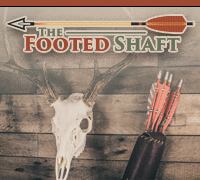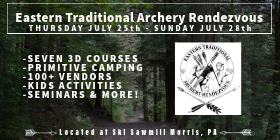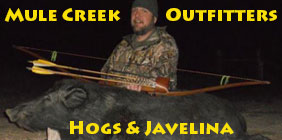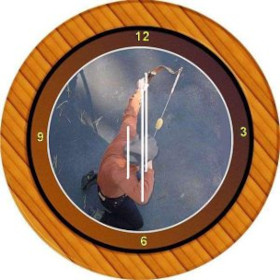I agree with the guys who suspect doweling marks or grain runout. I haven't read the books mentioned other than the Chet Stevenson book (GREAT read by the way) so I don't know if I'll repeat common knowledge but I'll try to give you a rundown of some things I look for.
You said the shafts were spruce but not what kind. I expect they are probably sitka spruce as that is the most common spruce wood used and is a very strong wood for it's weight. In fact, they used to use it the old wooden airplanes for that reason. Unfortunately, though I've made a bunch of wooden arrows, I've never used spruce.
I have seen many shafts though that had what I call "tear outs" that are usually a result of either a dull router bit, a small knot or a deviation in the grain possibly caused by a bend in the trunk or a knot that was near enough to distort the grain but got weeded out of the arrow process. This falls back to what aromakr said about shafts being cut from the log instead of split. A saw blade doesn't follow the grain so when a stick is turned down to a dowel, the grain doesn't always follow the shaft... I suspect even a sharp bit can cause tearout if the grain zigs or zags in the shaft. Usually it looks like a sort of rough area and is often the cause of a distinct kink in the shaft caused by distortion during drying. These defects seem to show up least on good quality cedar shafts which is what I use most of the time. The worst I've ever used was some chundoo but I know many others who've had great luck with it.
When I get a new batch of shafts, I sort first by natural straightness. I expect about 3 to 6 out of a dozen cedars to be real straight right out of the box. That's broadhead quality, spin perfect with no adjustment or must a minor tweek. So it goes without saying that something to look for in the raw shaft is that it is naturally straight. These are the shafts that "want to stay straight" and so don't tend to warp in your quiver. Put these "good ones" in a pile by themselves.
If a shaft is not straight when you get it, it should not have multiple bends or bends that look more like kinks. A shaft with a full length gentle curve can look pretty bad but will usually straighten more easily than one with multiple bends or a kink. Go through all your shafts and make a pile out of the ones that weren't straight when you got them but straightened easily. These are your #2's for now.
Any shaft that has a rough spot, resin spot or other surface defect should be examined closely for grain direction in that area. A rough spot not associated with bad grain can usually be smoothed and ignored. A distinct squiggle will usually mean a weak spot as will hard grain run out. These will become your rabbit arrows, flu-flus or stumpers.
Now, after you've straightened them all to the best of your ability, store them on a flat surface like the floor. I stick mine under the sofa in the den. In a couple of days, pull them out and recheck them for straightness. The TV makes a great backdrop for sighting down the shaft especially on a "blue screen" like when a DVD is stopped. The good #1's will likely still be good. If not, regrade accordingly. Now the good news...Several of the #2's will probably be as good as the #1's so upgrade them. Occasionally, even one of the multiple bend junkers will make it all the way into the #1 pile but don't count on it. It will likely take 3 to 5 straightenings to make a bad arrow that good... I usually go through this process several times over a couple weeks unless it's crunch time and I need arrows yesterday. It sure is best to plan ahead though...
One other arrow type to avoid like the plague is what I call "the noodle". I don't know what the heck causes it but some arrows are just kinda limp. Most shafts you buy will be resilient in feel to bending as straightening. That is, you have to over flex it to get it to spring back to straight. A "noodle" though.... when you bend it in any given direction, it just about stays right there. It's like bending a lead rod. I just flat throw these away. I've seen them in cedar, chundoo, maple and others and they are all bad juju.
By the way, I seldom use heat, a hook or any other form of pressure. If I can't get it straight just by hand I usually break it and move on. Them chundoos I mentioned were an exception. They needed both heat and pressure.
So, if you can go through this process and come up with 8 to 10 shafts out of dozen that are #1 or close to it you are doing well.
As for breakage, the only other thing is to be sure and orient your grain perpendicular to the string and if a shaft has gradual runout of the grain, try to put it running uphill as it points away from you. That way, if a shaft splits, it will be directed mostly away from your hand.
Sorry this is so long but It's an old bad habbit of mine to get "wordy" when I'm describing a process.....
One last thing...
The best way I've found to test the straightness of a shaft is to hold it horizontally near one end between my thumb and first or middle finger. Then I sort of lift the front and at the same time give the shaft a sharp spin with my fingers. The shaft spins very fast and any bend at all causes it to sort of buzz in your fingers which should stay in contact with the shaft but not hold it. You can even hear it. A perfect shaft just goes SSSSSSSSSSSSS faintly but a shaft with even a tiny bend will drum off your fingertips and sort of BUZZZZZZZZ as it rotates.
It's hard to describe but when you try it you will figure it out.
Hope this helps a little at least.














